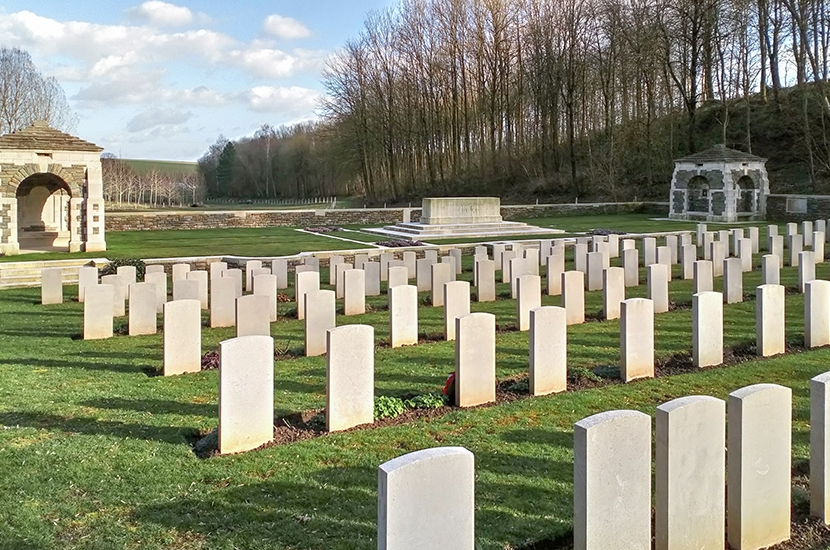They are starting to cut the corn. But apart from combine harvesters and tractors, the roads up here on the Somme ridges are empty, the villages more or less deserted. It’s been just me and my bike, the wind, the skylarks, the familiar English sky, the chalk ground, the strange flints, the green and famous woods, and the thousands of British dead lying under Portland headstones in these beautifully kept military cemeteries, the grander ones designed by Sir Herbert Baker. They dot the hillsides all around like defensive outposts of a lost civilisation of warrior gardeners.
Airport bookshops a few years ago were selling a paperback called Is it Just Me or is Everything Shit? Cycling the Somme battlefield this past week, I was convinced that if there is one thing in this stale and overcrowded world that has been saved, it is surely the Commonwealth War Graves Commission and their loving diligence towards our first world war dead.
The lawns and flower beds are flawless and the minute these century-old headstones show signs of weather erosion they are immediately replaced with a new one. The masons and engravers of the CWGC must be working flat out because I saw many of these pristine replacements. On some of the headstones, a brief well-chosen phrase has been appended to the stark name, age, rank, serial number, date of death and regimental badge of the deceased. ‘Remembered kindly by all’, I saw yesterday inscribed on the headstone of ‘A Ploughman, aged 26, of the Northamptonshire Regiment’. Even if you have no interest, sentimental or otherwise, in the Great War, but you enjoy gardening, I would still recommend a visit if only to admire the sharpness of the flower-bed edges.
My Uncle Bertie’s headstone, found in Becourt Military Cemetery, was shaded by a three-feet tall rose bush in full crimson bloom. A sergeant in the 10th Battalion Royal Fusiliers, otherwise known as the stockbrokers’ battalion, he was blown up on 9 July while enlarging a trench. I found him on the 104th anniversary of the explosion. Because I was tired and alone, and because I couldn’t think of anything else to do, I lay before his headstone, face down on the clipped grass, with my arms outstretched and listened to the wind in the treetops and the cacophony of summer birdsong.
In a rare outburst of florid emotion, the otherwise deadpan narrator of the Official History of the Great War says this about my Uncle Bertie:
No braver or more determined men ever faced an enemy than those sons of the British Empire who ‘went over the top’ on 1st July 1916. Never before had the ranks of a British Army in the field of battle contained the finest of all classes of the nation in physique, brains and education. And they were volunteers and not conscripts.
And when you arrive on the Somme battlefield and see with your own eyes the vast distances — half a mile, sometimes a mile — and the wide open spaces these green volunteers had to walk across, always, always uphill towards Germans firing machine guns capable of loosing off 500 rounds a minute, and accurate up to a mile, the negligence with which they were expended breaks your rotten heart.
I ate a rough picnic lunch with Uncle Bertie of fresh coleslaw and Passchendaele cheese. When I packed up and left, I somehow managed to leave behind my pocket knife and bicycle pump. In the course of a week I’ve left behind me in these soldiers’ graveyards a trail of small personal items. A pen here, a paperback there. And such is the scale of my egotism that when I turned the corner in Thiepval to be confronted with Lutyens’s staggering monument to the Missing of the Somme, a geometric marvel of arches inscribed with the names of 72,000 soldiers whose bodies were never found, I bracketed my penknife and bicycle pump within Lutyens’s grand remit. Here, too, the car park was empty, the visitor centre closed and I was alone on the steps with the 72,000 names. I hunted whimsically for, and found, George Butterworth the composer and three J. Clarkes.
Later that day I leaned my bike against the cemetery wall of Flatiron Copse. Thanks to first world war expert Paul Reed’s excellent weekly podcast, The Old Front Line, I knew that in here lay Edward Dwyer VC, aged 20, of the East Surrey Regiment. This former miner was made a poster boy for the recruiting drive and a wax record was made of him singing marching songs and telling of his war experiences. It is the only known recording of a Great War soldier in existence. He returned to the front and was shot dead fighting for Guillemont village. I stood before his headstone and listened through headphones to his strong clear voice singing ‘We’re here because we’re here because we’re here’. But he still seemed a very long way away.







Comments